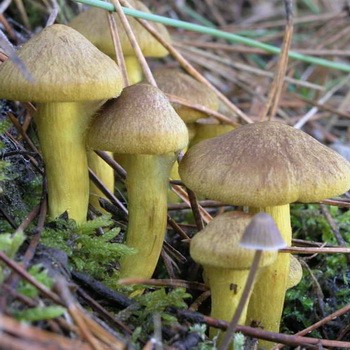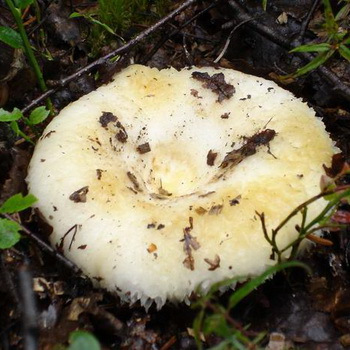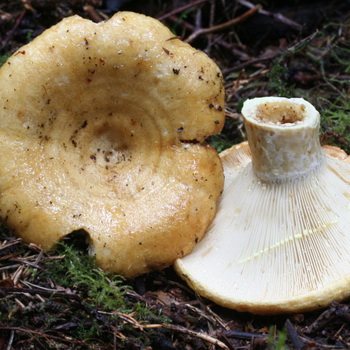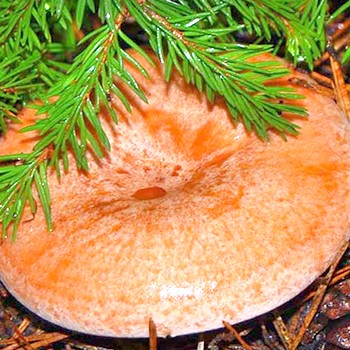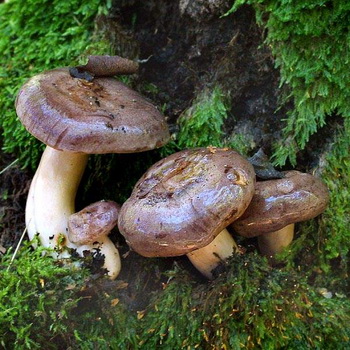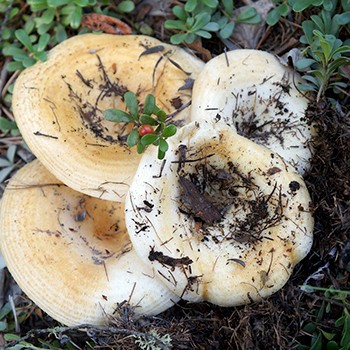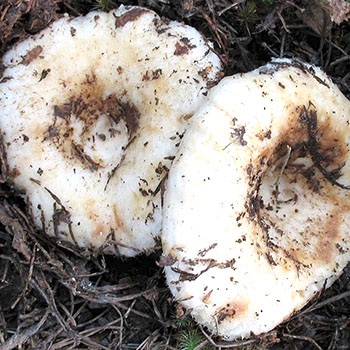What is the difference between breasts and podgruzki, violin and other mushrooms (with photo)
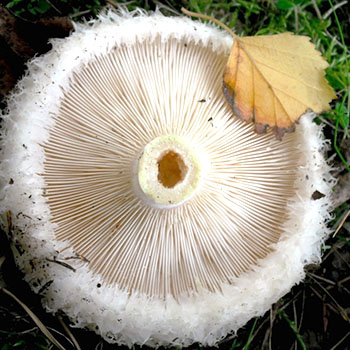
Content
- The main differences
- What is the difference between white breast and black
- The difference between white and load
- What is the difference between the breasts and the waves
- Differences between violinist and loader
- How to distinguish a white breast from a mustard
- Differences between black breast and pig
- What is the difference between the breast and the row of fir
- Differences between a white breast and a whitewater
- What is the difference between a false breast and the present
The main differences
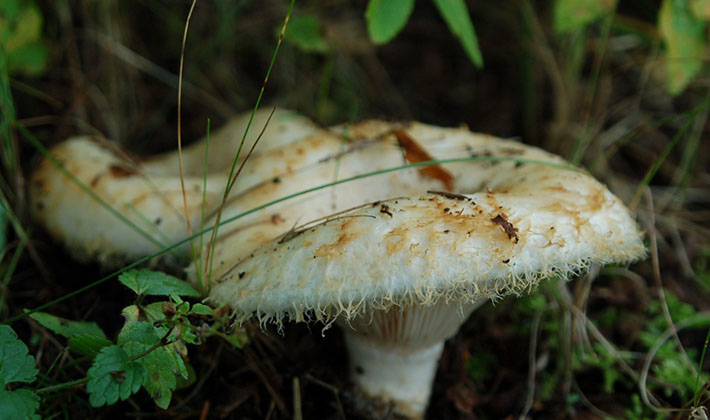 The hat is round, usually concave inward, funnel-shaped, white or yellowish in color, with large rusty spots, moist, slightly fluffy, with large fringe along the edges. The plates are white, yellowish. The pulp is white, dense, juicy, thick, and secrets a bitter milky juice, especially when broken. The leg is short, white, hollow inside. Relate to the "plate" mushrooms, in which the lower part of the caps consists of delicate plates. Next, we consider the main differences between the mushrooms from a number of mushrooms that are similar in appearance.
The hat is round, usually concave inward, funnel-shaped, white or yellowish in color, with large rusty spots, moist, slightly fluffy, with large fringe along the edges. The plates are white, yellowish. The pulp is white, dense, juicy, thick, and secrets a bitter milky juice, especially when broken. The leg is short, white, hollow inside. Relate to the "plate" mushrooms, in which the lower part of the caps consists of delicate plates. Next, we consider the main differences between the mushrooms from a number of mushrooms that are similar in appearance.
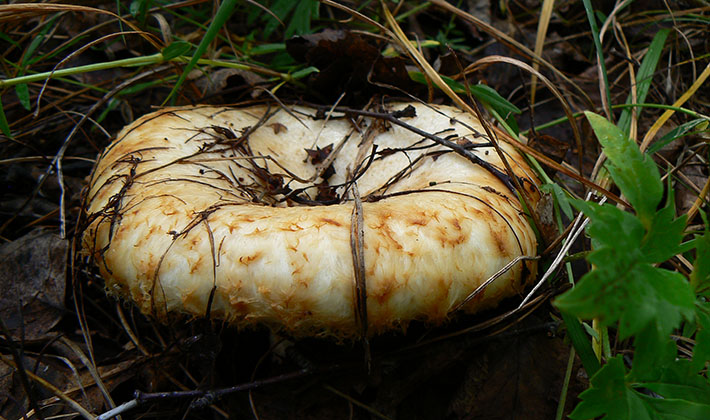 Grows in birch forests and mixed forests mixed with birch. It is quite rare, but sometimes in large groups, from July to October. The cap is large, up to 20 cm in diameter, in young mushrooms it is white, round-convex, then funnel-shaped, with a hairy edge tucked down, white or slightly yellowish, often with slightly noticeable watery concentric stripes. In wet weather, it is mucous, for which this mushroom is called "raw breast." The pulp is white, dense, brittle, with a spicy smell.
Grows in birch forests and mixed forests mixed with birch. It is quite rare, but sometimes in large groups, from July to October. The cap is large, up to 20 cm in diameter, in young mushrooms it is white, round-convex, then funnel-shaped, with a hairy edge tucked down, white or slightly yellowish, often with slightly noticeable watery concentric stripes. In wet weather, it is mucous, for which this mushroom is called "raw breast." The pulp is white, dense, brittle, with a spicy smell.
Milky juice is white, pungent, bitter in taste, becomes sulfur-yellow in the air.
Legs descending on the leg, white or cream, with a yellowish edge, wide, rare. The stalk is short, thick, naked, white, sometimes with yellowish spots, in mature mushrooms it is hollow inside. Conditionally edible, the first category. Used for pickling, less often for pickling. Salty breasts have a bluish tint.
What is the difference between white breast and black
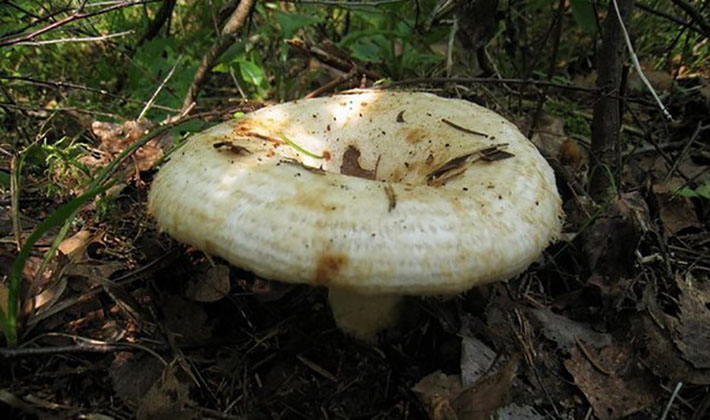 Grows in coniferous and deciduous forests. It occurs singly and in groups from July to October, and sometimes in November. Hat with a diameter of up to 20 cm, almost flat, with a hollow in the middle and a curled edge. The hat later becomes funnel-shaped with straightened edges. The surface is slightly sticky, olive-brown, lighter to the edge.The first thing that distinguishes white breast from black is the color of the exterior. The plates are dirty whitish, later with brownish spots. When pressed, they darken.
Grows in coniferous and deciduous forests. It occurs singly and in groups from July to October, and sometimes in November. Hat with a diameter of up to 20 cm, almost flat, with a hollow in the middle and a curled edge. The hat later becomes funnel-shaped with straightened edges. The surface is slightly sticky, olive-brown, lighter to the edge.The first thing that distinguishes white breast from black is the color of the exterior. The plates are dirty whitish, later with brownish spots. When pressed, they darken.
 The leg is short, thick, first solid, then hollow. The pulp is dense, white or grayish-white, with a plentiful white, pungent milky juice, darkens at the break. Black breasts are good for pickling. Thoroughly washed and soaked, they lose their bitterness, their flesh becomes crispy, dense. In the pickle, the hat acquires a beautiful dark violet-cherry color. Mushrooms black in salting for years do not lose strength and taste. Conditionally edible, third category.
The leg is short, thick, first solid, then hollow. The pulp is dense, white or grayish-white, with a plentiful white, pungent milky juice, darkens at the break. Black breasts are good for pickling. Thoroughly washed and soaked, they lose their bitterness, their flesh becomes crispy, dense. In the pickle, the hat acquires a beautiful dark violet-cherry color. Mushrooms black in salting for years do not lose strength and taste. Conditionally edible, third category.
The difference between white and load
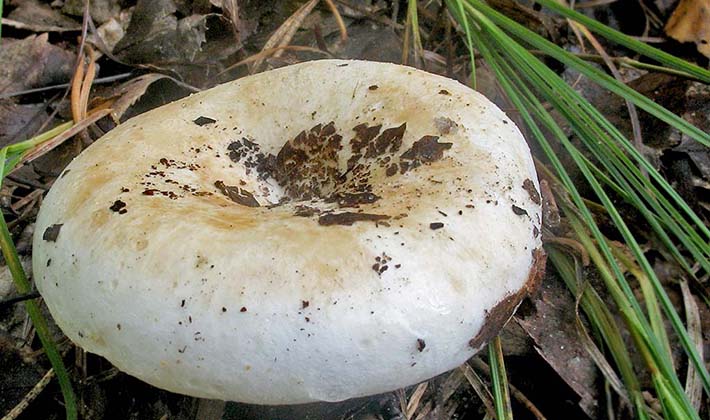 The hat is more concave than a real hat, less fluffy. In young podgruzdy, the edges of the hats are also turned inward, but not completely lowered. Hat and rare white plates. The pulp is white, with a break, bitter milky juice is secreted. Dry surface and white color are the hallmarks of this mushroom.
The hat is more concave than a real hat, less fluffy. In young podgruzdy, the edges of the hats are also turned inward, but not completely lowered. Hat and rare white plates. The pulp is white, with a break, bitter milky juice is secreted. Dry surface and white color are the hallmarks of this mushroom.
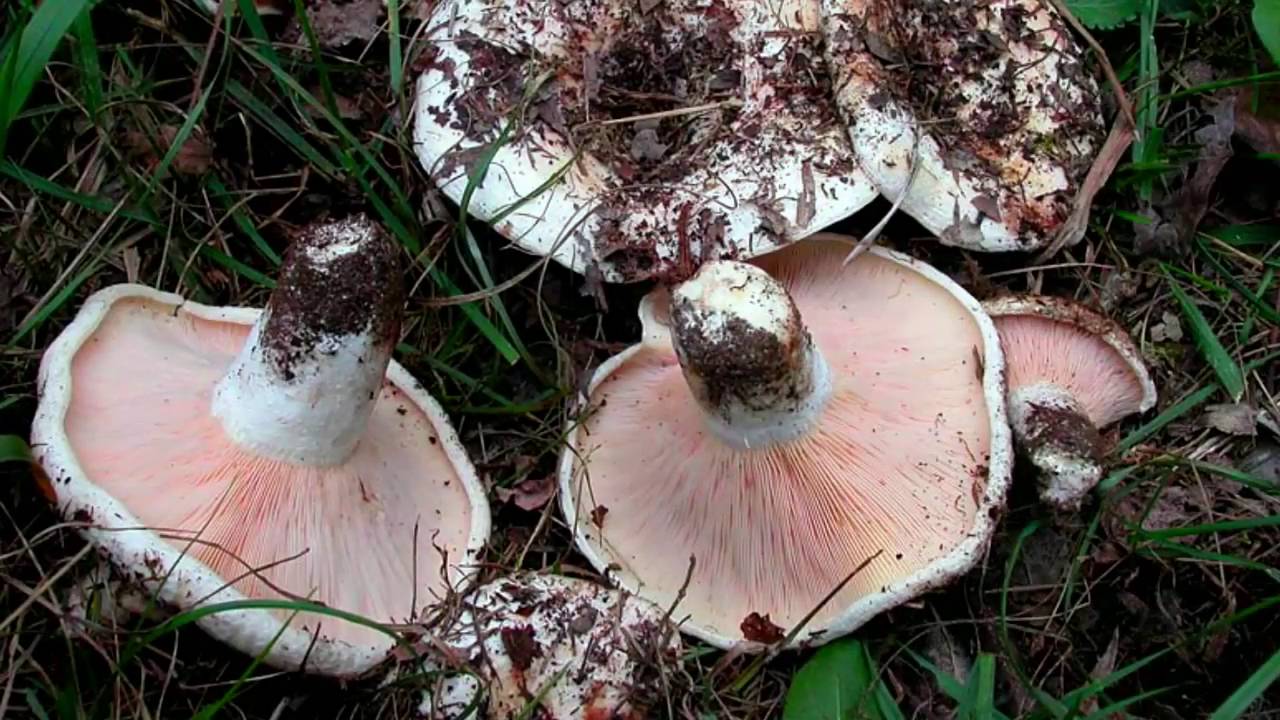 It grows from late July to late autumn. The main difference between the white load and the load is that it is found in coniferous, deciduous and mixed forests of the northern part of the forest zone. It grows from July to October. The hat is a load of white - up to 20 cm in diameter - first flat-convex with a curved edge and a depression in the middle, then funnel-shaped with straightening edges, pure white, sometimes with brownish-yellow spots (tan marks). Leg up to 5 cm long, flat, first solid, then hollow, white. The pulp is white; it does not change at the break, the pulp is moist in the fabric of the hat, and caustic in the plates. The plates are descending, narrow, clean, sometimes forked, bifurcated, white toward the outer edge.
It grows from late July to late autumn. The main difference between the white load and the load is that it is found in coniferous, deciduous and mixed forests of the northern part of the forest zone. It grows from July to October. The hat is a load of white - up to 20 cm in diameter - first flat-convex with a curved edge and a depression in the middle, then funnel-shaped with straightening edges, pure white, sometimes with brownish-yellow spots (tan marks). Leg up to 5 cm long, flat, first solid, then hollow, white. The pulp is white; it does not change at the break, the pulp is moist in the fabric of the hat, and caustic in the plates. The plates are descending, narrow, clean, sometimes forked, bifurcated, white toward the outer edge.
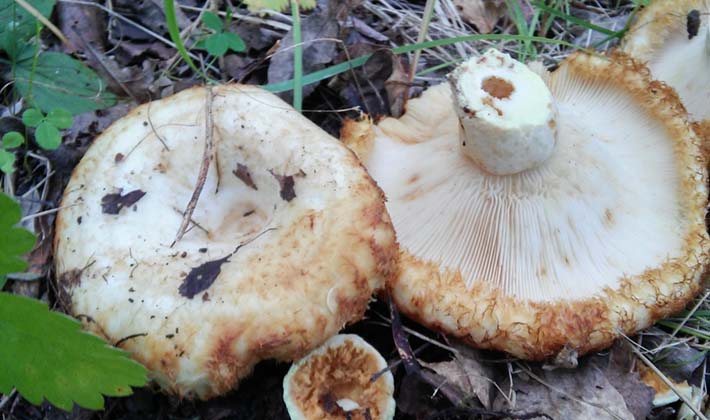 Usually this mushroom is salted. The salty load acquires a slightly brownish color. In many places, white podgruzki called "dry breasts" in contrast to the real breasts, in which the hat is usually a little slimy. White podgruzki differ from the actual pogruzdy in other ways. The edges of the caps are not pubescent; the flesh does not contain milky juice. Conditionally edible, the second category, used salted and pickled. In the northern half of the forest zone, there is another type of preload - black preload. The hat is up to 15 cm in diameter, flat-convex with a hollow in the middle and with a curled edge, later funnel-shaped, glabrous, slightly sticky, from dirty gray to dark brown in color.
Usually this mushroom is salted. The salty load acquires a slightly brownish color. In many places, white podgruzki called "dry breasts" in contrast to the real breasts, in which the hat is usually a little slimy. White podgruzki differ from the actual pogruzdy in other ways. The edges of the caps are not pubescent; the flesh does not contain milky juice. Conditionally edible, the second category, used salted and pickled. In the northern half of the forest zone, there is another type of preload - black preload. The hat is up to 15 cm in diameter, flat-convex with a hollow in the middle and with a curled edge, later funnel-shaped, glabrous, slightly sticky, from dirty gray to dark brown in color.
The pulp is white or grayish-white, without milky juice.
The plates are often grayish-dirty in color, blacken when pressed. For the dark color of the hat, the mushroom is sometimes called "cinnamon", and for brittle flesh - "Russula black." These mushrooms are often wormy. His records are very caustic. For the ambassador, it must be boiled. In salty and boiled form - dark brown color. Conditionally edible, the third category, used only for salt. Salted mushrooms turn black.
Look at the difference between the breasts and the load in the photo, which shows the main differences.
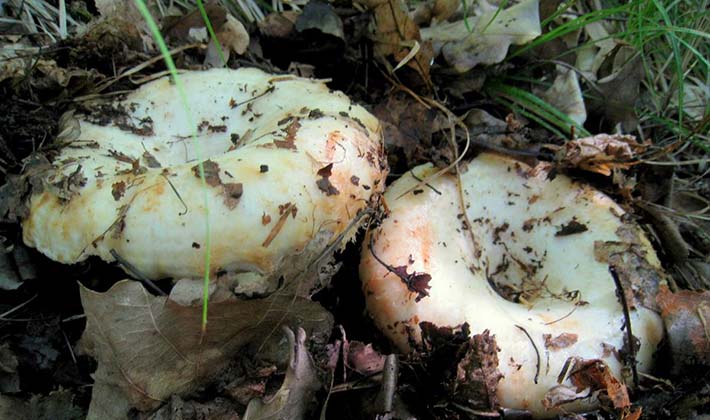
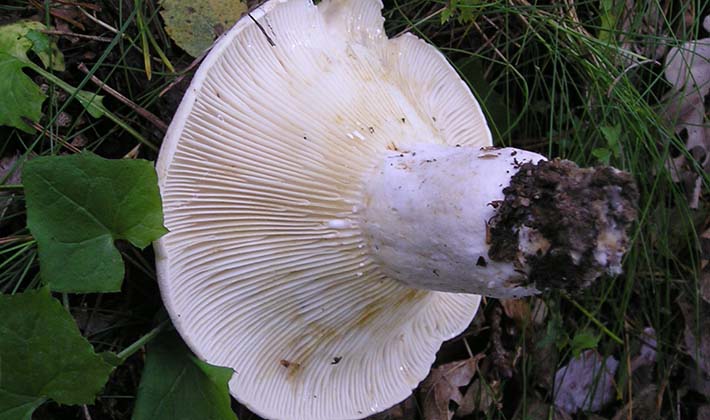
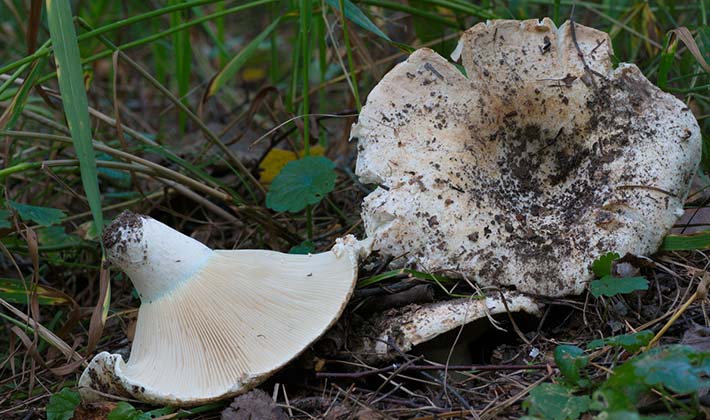
What is the difference between the breasts and the waves
It grows from late August until the first frost, mostly alone in birch forests and mixed forests, mainly in the northern part of the forest zone. A hat with a diameter of up to 12 cm, first flat with a pit in the center and with a curled edge, later funnel-shaped, fibrous, hairy along the edge, woolly. Let's see how the breasts differ from the waves and how to differentiate them in the field.
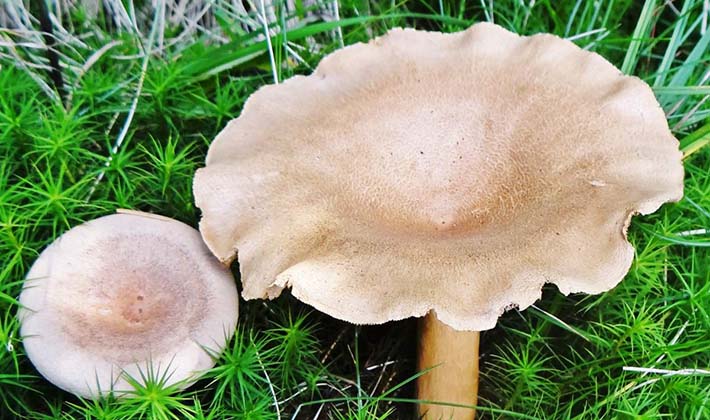 In wet weather, the hat in the middle is sticky, pink or yellowish-pink, with pronounced dark concentric zones. The plates are grown or descending, thin, white or slightly pinkish. Leg up to 6 cm long, up to 2 cm in diameter, cylindrical, hollow, one-color with a hat. The pulp is friable, brittle, white or pinkish, with a white, pungent, milky juice. The trefoil is used for salting. Fill it only after thorough soaking and boiling, otherwise the mushrooms can cause severe irritation of the gastric mucosa.It is best to pick up young mushrooms for pickling, up to 3-4 cm. Their hat is strong, with the edge wrapped deep inside. Such small waves are called "curl." In salty form, it has a pale brown with an admixture of pink color, it retains pronounced dark areas. In the northwestern and central regions of the country and in the Urals, usually on the fringes of young birch forests from early August to October, you can find a white thunder (white whale). It is in many ways similar to the pink thunder, but smaller than it. The cap with a diameter of up to 6 cm is fluffy-silky, at first convex, later funnel-shaped, white with yellowish-reddish, as if blurry spots, with a wrapped hairy edge. White milky juice is sharp, sometimes bitter. The plates are pale yellow, slightly pinkish, overgrown or descending, frequent, narrow. The leg is dense, brittle, short, smooth. The flesh is white or slightly pinkish. Whitefish is sometimes confused with white. But the last hat is much larger, and around the edge naked or slightly pubescent. It only goes into salting after preliminary soaking in water or scalding with boiling water. Belyanka is valued for its delicate flesh and pleasant taste. In a salt form light brownish. The mushroom is conditionally edible, the second category.
In wet weather, the hat in the middle is sticky, pink or yellowish-pink, with pronounced dark concentric zones. The plates are grown or descending, thin, white or slightly pinkish. Leg up to 6 cm long, up to 2 cm in diameter, cylindrical, hollow, one-color with a hat. The pulp is friable, brittle, white or pinkish, with a white, pungent, milky juice. The trefoil is used for salting. Fill it only after thorough soaking and boiling, otherwise the mushrooms can cause severe irritation of the gastric mucosa.It is best to pick up young mushrooms for pickling, up to 3-4 cm. Their hat is strong, with the edge wrapped deep inside. Such small waves are called "curl." In salty form, it has a pale brown with an admixture of pink color, it retains pronounced dark areas. In the northwestern and central regions of the country and in the Urals, usually on the fringes of young birch forests from early August to October, you can find a white thunder (white whale). It is in many ways similar to the pink thunder, but smaller than it. The cap with a diameter of up to 6 cm is fluffy-silky, at first convex, later funnel-shaped, white with yellowish-reddish, as if blurry spots, with a wrapped hairy edge. White milky juice is sharp, sometimes bitter. The plates are pale yellow, slightly pinkish, overgrown or descending, frequent, narrow. The leg is dense, brittle, short, smooth. The flesh is white or slightly pinkish. Whitefish is sometimes confused with white. But the last hat is much larger, and around the edge naked or slightly pubescent. It only goes into salting after preliminary soaking in water or scalding with boiling water. Belyanka is valued for its delicate flesh and pleasant taste. In a salt form light brownish. The mushroom is conditionally edible, the second category.
Differences between violinist and loader
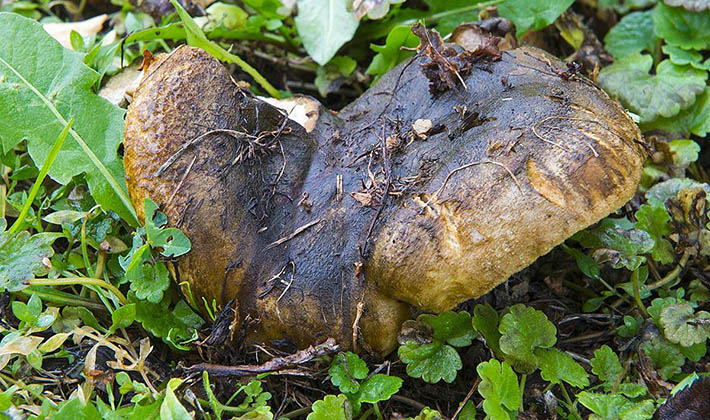 Quite often found in coniferous and deciduous forests of the middle zone, in large groups, from mid-June to mid-September. A hat with a diameter of up to 20 cm, first flat-convex, in the middle of a depression, with a curled edge. The difference between a violinist and a loader is that later the hat becomes funnel-shaped with a wavy, often cracked edge. The surface is dry, slightly pubescent, pure white, later slightly buffy. The plates are rare, whitish or yellowish. Leg up to 6 cm long, thick, slightly narrowed at the base, solid, white. The pulp is coarse, dense, white, later yellowish, with a plentiful white, pungent, milky sap. The collected mushrooms in a basket rub against each other and emit a characteristic creak. For this they were called “violinists”, “violinists”. Mushroom pickers do not always take these mushrooms, although they are used for salting, becoming strong and gaining a lavish smell. The mushroom turns white with a bluish tint and creaks on the teeth. The mushroom is conditionally edible, the fourth category. Used for salt and pickling. Previously, it needs to be soaked and boiled to remove bitterness.
Quite often found in coniferous and deciduous forests of the middle zone, in large groups, from mid-June to mid-September. A hat with a diameter of up to 20 cm, first flat-convex, in the middle of a depression, with a curled edge. The difference between a violinist and a loader is that later the hat becomes funnel-shaped with a wavy, often cracked edge. The surface is dry, slightly pubescent, pure white, later slightly buffy. The plates are rare, whitish or yellowish. Leg up to 6 cm long, thick, slightly narrowed at the base, solid, white. The pulp is coarse, dense, white, later yellowish, with a plentiful white, pungent, milky sap. The collected mushrooms in a basket rub against each other and emit a characteristic creak. For this they were called “violinists”, “violinists”. Mushroom pickers do not always take these mushrooms, although they are used for salting, becoming strong and gaining a lavish smell. The mushroom turns white with a bluish tint and creaks on the teeth. The mushroom is conditionally edible, the fourth category. Used for salt and pickling. Previously, it needs to be soaked and boiled to remove bitterness.
How to distinguish a white breast from a mustard
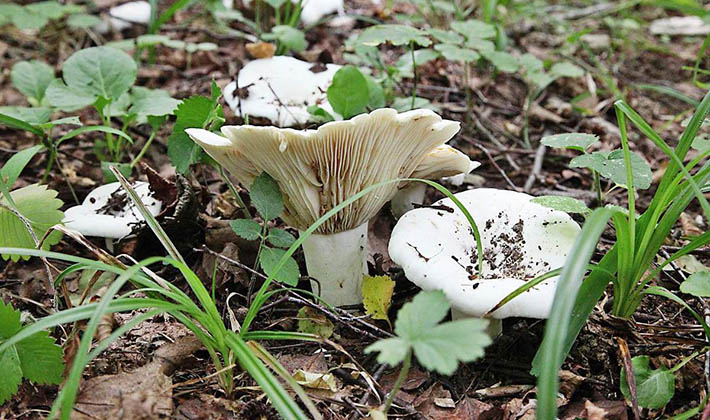 You need to know how to distinguish a white breast from a mustard, since it is found everywhere, but mainly in the northern half of the forest zone. Prefers a few moist forests. It usually grows in large groups. The cap is up to 8 cm in diameter, initially flat-convex, then funnel-shaped, usually with a tubercle in the middle, dry, silky, red-brown. Lamellas descending or adherent, frequent, pale reddish-yellowish, usually with a white coating from spores. Leg up to 8 cm long, flat, cylindrical, first solid, then hollow, light reddish-brown, at the base with white felt. The pulp is dense, first white, then slightly reddish-brown without a special smell. Milky juice is white and very caustic; it is not without reason that the mushroom was called bitter. Due to the very bitter, pungent taste, the mushrooms are only salted, they must first be boiled and only after that they are salted. The salty mushrooms are dark brown in color, with a noticeable sharp tubercle on the hat. The mushroom is conditionally edible, the fourth category.
You need to know how to distinguish a white breast from a mustard, since it is found everywhere, but mainly in the northern half of the forest zone. Prefers a few moist forests. It usually grows in large groups. The cap is up to 8 cm in diameter, initially flat-convex, then funnel-shaped, usually with a tubercle in the middle, dry, silky, red-brown. Lamellas descending or adherent, frequent, pale reddish-yellowish, usually with a white coating from spores. Leg up to 8 cm long, flat, cylindrical, first solid, then hollow, light reddish-brown, at the base with white felt. The pulp is dense, first white, then slightly reddish-brown without a special smell. Milky juice is white and very caustic; it is not without reason that the mushroom was called bitter. Due to the very bitter, pungent taste, the mushrooms are only salted, they must first be boiled and only after that they are salted. The salty mushrooms are dark brown in color, with a noticeable sharp tubercle on the hat. The mushroom is conditionally edible, the fourth category.
Differences between black breast and pig
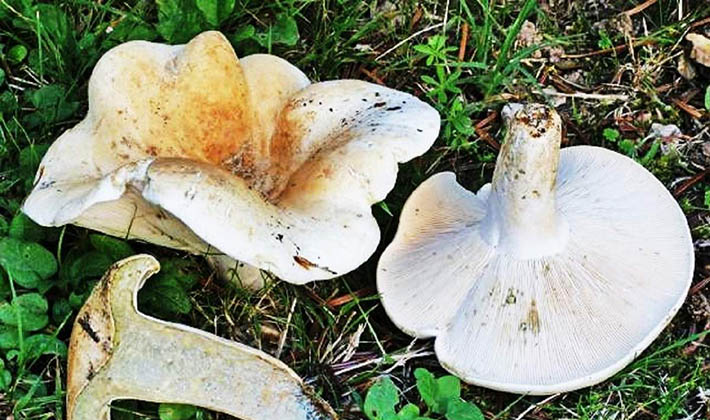 Pig, a genus of agaric mushrooms. The difference between a pig and a loaf is that it has a hat with a diameter of up to 20 cm, first convex, then flat, funnel-shaped, with the edge turned inward, velvety, yellow-brown, sometimes with an olive tint. The flesh is light brown, darkening on the cut. The plates are down-bound, connected below by transverse veins, easily separated from the cap. Leg dl. up to 9 cm, central or sideways, narrowed down, of the same color with a hat.Mushroom grows in forests of various types, in large groups, from July to October, can form mycorrhiza.
Pig, a genus of agaric mushrooms. The difference between a pig and a loaf is that it has a hat with a diameter of up to 20 cm, first convex, then flat, funnel-shaped, with the edge turned inward, velvety, yellow-brown, sometimes with an olive tint. The flesh is light brown, darkening on the cut. The plates are down-bound, connected below by transverse veins, easily separated from the cap. Leg dl. up to 9 cm, central or sideways, narrowed down, of the same color with a hat.Mushroom grows in forests of various types, in large groups, from July to October, can form mycorrhiza.
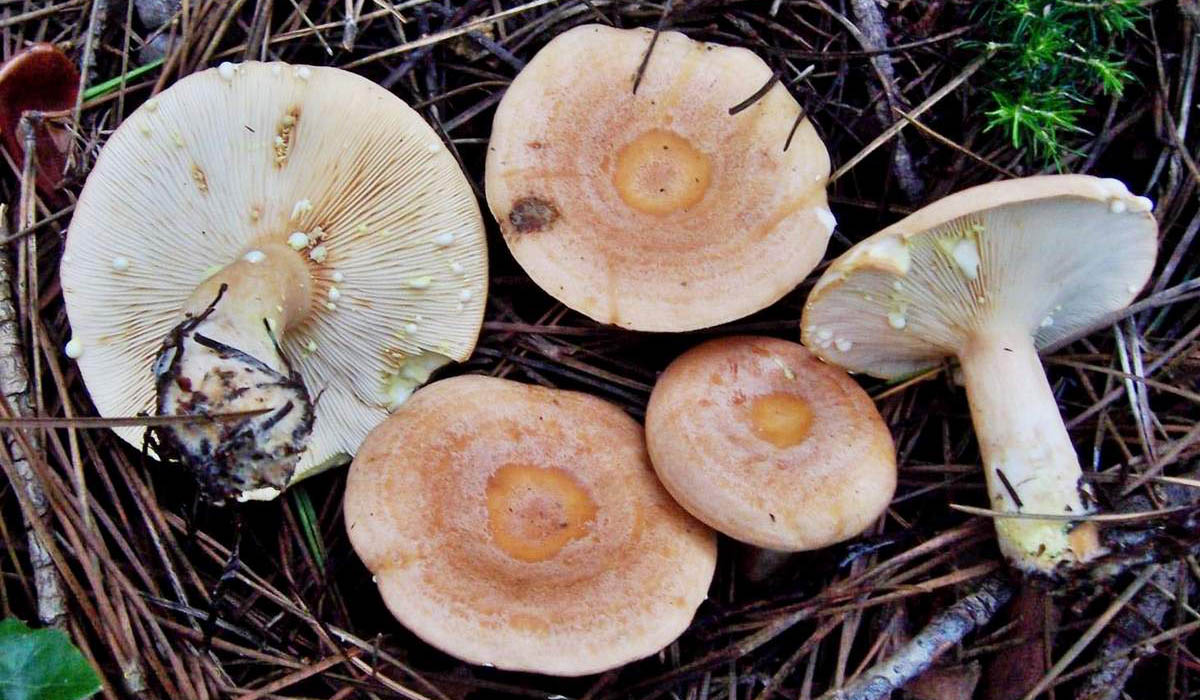 It is necessary to know the difference between a black breast and a pig, since in recent years the pig is classified as a poisonous mushroom (it can cause poisoning, even fatal). It contains substances that lead to a decrease in red blood cells in the blood. Moreover, the manifestation of poisoning depends on the individual characteristics of the human body and can occur both several hours later and several years after the use of these mushrooms. The fat pig is distinguished by larger sizes, a dark brown velvety leg. Forms mycorrhiza or settles on wood. Conditionally edible. Pigs have the ability to accumulate harmful compounds of heavy metals.
It is necessary to know the difference between a black breast and a pig, since in recent years the pig is classified as a poisonous mushroom (it can cause poisoning, even fatal). It contains substances that lead to a decrease in red blood cells in the blood. Moreover, the manifestation of poisoning depends on the individual characteristics of the human body and can occur both several hours later and several years after the use of these mushrooms. The fat pig is distinguished by larger sizes, a dark brown velvety leg. Forms mycorrhiza or settles on wood. Conditionally edible. Pigs have the ability to accumulate harmful compounds of heavy metals.
What is the difference between the breast and the row of fir
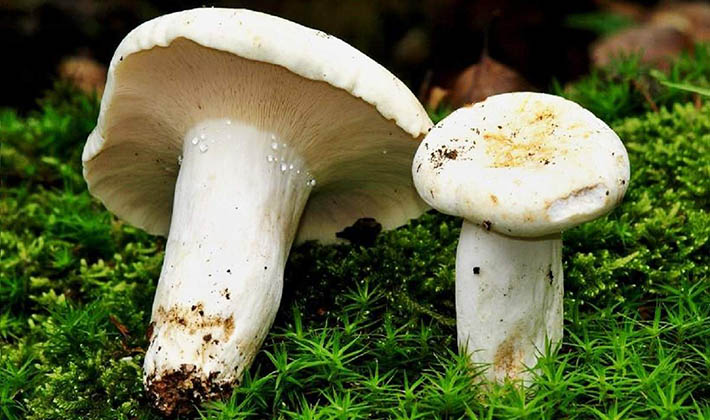 It grows on sandy soil in coniferous, mainly pine forests from August to autumn frosts, singly and in small groups. It is widespread everywhere, but it is quite rare. The cap is up to 10 cm in diameter, fibrous, mucous-sticky, initially flat-convex, then half-spread, from light gray to dark gray, often with a yellowish or purple hue, darker in the center than along the edge, with radial dark stripes .
It grows on sandy soil in coniferous, mainly pine forests from August to autumn frosts, singly and in small groups. It is widespread everywhere, but it is quite rare. The cap is up to 10 cm in diameter, fibrous, mucous-sticky, initially flat-convex, then half-spread, from light gray to dark gray, often with a yellowish or purple hue, darker in the center than along the edge, with radial dark stripes .
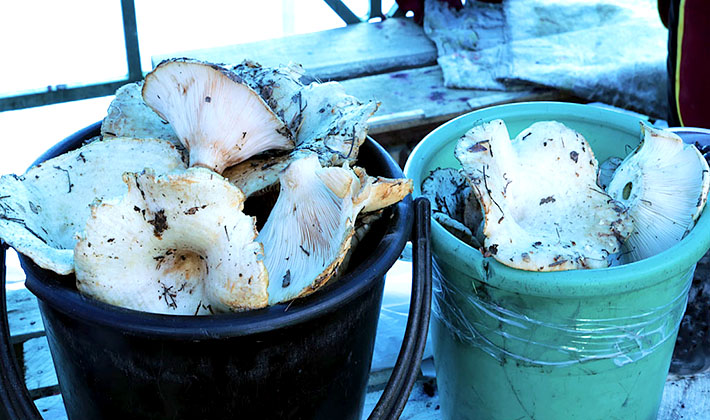 Most importantly, the difference between the breast and the spruce row is that its flesh is not brittle, white, does not turn yellow in the air, with a faint smell of flour, fresh to the taste. The plates are white, then light yellow or bluish-gray, rare, wide. Leg up to 10 cm long and up to 2 cm thick, flat, white, then yellowish or grayish, fibrous, sits deep in the soil. The mushroom is edible, the fourth category. Used boiled, fried, salted and pickled.
Most importantly, the difference between the breast and the spruce row is that its flesh is not brittle, white, does not turn yellow in the air, with a faint smell of flour, fresh to the taste. The plates are white, then light yellow or bluish-gray, rare, wide. Leg up to 10 cm long and up to 2 cm thick, flat, white, then yellowish or grayish, fibrous, sits deep in the soil. The mushroom is edible, the fourth category. Used boiled, fried, salted and pickled.
Differences between a white breast and a whitewater
 In the northwestern and central regions of the country and in the Urals, usually on the fringes of young birch forests from early August to October, you can find a white thunder (white whale). It is in many ways similar to the pink thunder, but smaller than it. The difference between white and white breast is as follows: a hat with a diameter of up to 6 cm is fluffy-silky, initially convex, later funnel-shaped, white with yellowish-reddish, as if blurry spots, with a wrapped hairy edge.
In the northwestern and central regions of the country and in the Urals, usually on the fringes of young birch forests from early August to October, you can find a white thunder (white whale). It is in many ways similar to the pink thunder, but smaller than it. The difference between white and white breast is as follows: a hat with a diameter of up to 6 cm is fluffy-silky, initially convex, later funnel-shaped, white with yellowish-reddish, as if blurry spots, with a wrapped hairy edge.
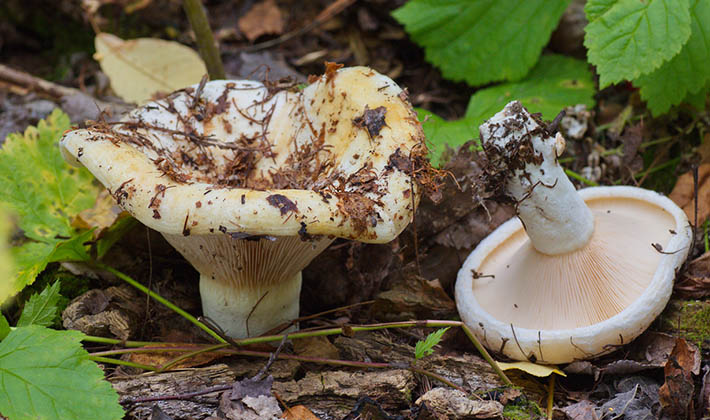 White milky juice is sharp, sometimes bitter. The plates are pale yellow, slightly pinkish, overgrown or descending, frequent, narrow. The leg is dense, brittle, short, smooth. The difference between the breasts and the waves is that their pulp is always white, and not slightly pinkish. Whitefish is sometimes confused with white. But the last hat is much larger, and around the edge naked or slightly pubescent. It only goes into salting after preliminary soaking in water or scalding with boiling water. Belyanka is valued for its delicate flesh and pleasant taste. In a salt form light brownish.
White milky juice is sharp, sometimes bitter. The plates are pale yellow, slightly pinkish, overgrown or descending, frequent, narrow. The leg is dense, brittle, short, smooth. The difference between the breasts and the waves is that their pulp is always white, and not slightly pinkish. Whitefish is sometimes confused with white. But the last hat is much larger, and around the edge naked or slightly pubescent. It only goes into salting after preliminary soaking in water or scalding with boiling water. Belyanka is valued for its delicate flesh and pleasant taste. In a salt form light brownish.
What is the difference between a false breast and the present
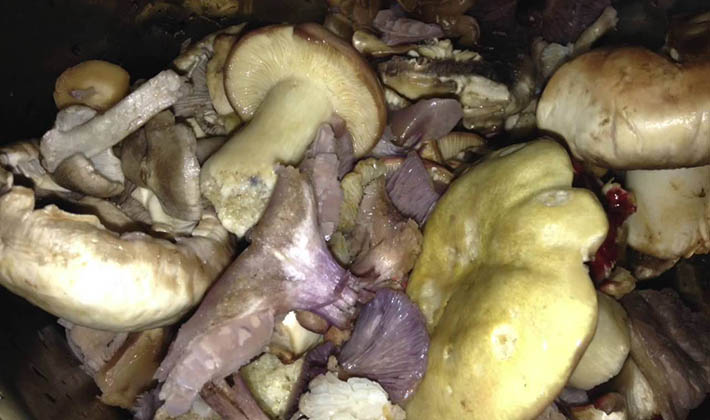 The first thing that distinguishes a false breast from a real one is a hat with a diameter of 4-12 cm, densely fleshy, convex- or flat-spaced to a funnel-shaped, sometimes with a tubercle, initially with a bent, and later with a lowered edge, dry, silky-fibrous, finely scaly, with age almost naked, ocher-meat-reddish, ocher-dirty-pinkish-gray or pinkish-brownish, when dried with blurry spots. The plates are descending, narrow, thin, whitish, later pinkish-cream and orange-ocher. Leg 4-8 × 0.8–3.5 cm, cylindrical, dense, eventually hollow, felt, at the base hairy-felt, the color of a hat, in the upper part lighter, mealy. The flesh is yellowish with a reddish tinge; the lower part of the leg is reddish-brownish, sweet, without any particular smell (when dried, with the smell of coumarin); milky juice is watery, sweet or bitter, does not change color in air. It grows in moist coniferous and deciduous forests. Forms fruiting bodies in July - October. Poisonous mushroom.
The first thing that distinguishes a false breast from a real one is a hat with a diameter of 4-12 cm, densely fleshy, convex- or flat-spaced to a funnel-shaped, sometimes with a tubercle, initially with a bent, and later with a lowered edge, dry, silky-fibrous, finely scaly, with age almost naked, ocher-meat-reddish, ocher-dirty-pinkish-gray or pinkish-brownish, when dried with blurry spots. The plates are descending, narrow, thin, whitish, later pinkish-cream and orange-ocher. Leg 4-8 × 0.8–3.5 cm, cylindrical, dense, eventually hollow, felt, at the base hairy-felt, the color of a hat, in the upper part lighter, mealy. The flesh is yellowish with a reddish tinge; the lower part of the leg is reddish-brownish, sweet, without any particular smell (when dried, with the smell of coumarin); milky juice is watery, sweet or bitter, does not change color in air. It grows in moist coniferous and deciduous forests. Forms fruiting bodies in July - October. Poisonous mushroom.
See how to distinguish a white breast from a false one in a video showing all the features.
